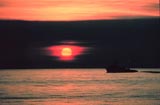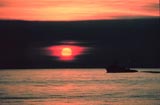
To Improve Water Quality, Manage the Landscape
 In the last 20 years, water quality managers have come to more fully appreciate that the old categories of both management and regulation are breaking down and collapsing in upon themselves.
In the last 20 years, water quality managers have come to more fully appreciate that the old categories of both management and regulation are breaking down and collapsing in upon themselves.
Quantity versus quality, surface versus groundwater, point versus nonpoint sources, chemical versus physical and biological integrity—these are the traditional cookie jars in which we separated management of what is really an integrated resource characterized by the connectivity of all its component parts.
In terms of current water quality problems, the most significant realization is this: you cannot improve water quality without sustainably managing the landscape, the watershed if you will, in either the rural or urban contexts. There are examples to be found in numerous communities and watersheds, at every geographic or spatial scale, but let’s look at just two of the biggest interstate challenges facing America today.
The Gulf of Mexico
I recently had the privilege of serving on a committee of the National Academies’ National Research Council on the Mississippi River and the Clean Water Act. The committee looked at the river itself as well as its relationship to the Gulf of Mexico with its ever-growing hypoxic or so-called “Dead Zone.”
In its final report,1 issued in October, the committee noted that almost 90 percent of the nitrogen flowing into the Gulf of Mexico, the primary cause of its over-enrichment and oxygen depletion ( hence, the “Dead Zone”), comes from unregulated, diffuse, nonpoint source pollution or runoff, including approximately 58 percent from fertilizer and mineralized soil nitrogen. And a report released Jan. 29 by the U.S. Geological Survey indicates that agricultural nonpoint sources contribute more than 70 percent of the nitrogen and phosphorous delivered to the Gulf, versus only 9 to 12 percent from urban sources.2 This means that the federal Clean Water Act, enforced largely through state-delegated programs, cannot address these concerns because they are not regulated “point sources” or discharge pipes.3 These sources are beyond the reach of the act. Therefore, an exclusive end-of-the pipe focus on such traditional pollution sources will not yield any significant improvements in the Gulf of Mexico.
To put it another way, the 2007 Farm Bill, with its massive conservation programs, may be of greater importance to reducing nonpoint source pollution rather than the Clean Water Act. Unfortunately, its conservation benefits may be offset by federal subsidies for ethanol production and corn growing that encourage additional planting and fertilizer treatments, resulting in more nonpoint source pollution or runoff.
Chesapeake Bay
The Chesapeake Bay is another large-scale watershed, encompassing part of six states and the District of Columbia. EPA and its state partners are implementing new state-of-the-art water quality criteria in the water permits of all regulated point sources in the basin. This is good news in that it will result in further reductions in nutrient loadings to this world-class water body. However, EPA and its state partners estimate that agricultural nitrogen loads are approximately 40 percent of total nitrogen pollution. This is a combination of atmospherically deposited nitrogen, chemical fertilizer applications, and animal manure applications.
For phosphorus, another nutrient impacting Bay water quality, 45 percent of total loads to the tidal waters come from agricultural lands, primarily due to chemical fertilizer and animal manure applications.
Hardscape
While agricultural nonpoint source pollution is a major challenge on Chesapeake Bay, a more ominous challenge is the growth of impervious surfaces—roads, sidewalks, roofs, parking lots—that result in more stormwater runoff and accelerated velocities, which destroy streams and tributaries. You might be able to change agricultural practices over time; but once you pave Paradise, it is very difficult to retrofit the urban landscape.
Between 1990 and 2000, impervious surfaces in the Bay watershed increased from 611,017 to 860,004 acres. At that rate, an additional 250,000 acres will become impervious by 2010 as exceptional economic growth and the quest for prime real estate usher in their usual attendants: traffic congestion, deforestation, polluted runoff, and the loss of natural systems—terrestrial as well as aquatic.
The Potomac Conservancy recently issued its report, "State of the Nation’s River: Potomac Watershed 2007" giving this tributary to the Chesapeake Bay a D+ for overall health, primarily due to stress from poor land use.4 Full disclosure: I am a member of the board of this organization.
The amount of the developed land in the watershed has doubled since 1970. In the next 20 years, the population of the Potomac watershed is expected to grow 10 percent each decade, adding 1 million inhabitants. For every 8 percent increase in population, count on a 41 percent increase in impervious surfaces. Again, this will result in loss of forest cover and an increase in impervious surfaces, more pollution, and something called “urban stream syndrome.”
“Urban stream syndrome” is characterized by flash flooding, elevated nutrient and contaminant levels, altered stream morphology, sedimentation from eroded stream banks, and loss of species diversity.
There is almost no direct regulation, say, of row crop agriculture. Some USDA farm programs require certain best management practices and large livestock operations are permitted. This is not likely to change anytime soon. So conservation dollars to encourage sound practices on the land, derived from either the Farm Bill, state and local government, or private watershed or land trust organizations, will be the tool of choice for some time. Water quality trading between point and nonpoint sources might also accelerate better practices on the land at least cost. State departments of agriculture, land grant colleges, and extension agents will hopefully assist agricultural producers to find cost-effective, even profitable, ways of reducing inputs and thereby reduce pollution. And states may choose to use their own legal authorities to pursue regulations to complement and “incentivize” market-based approaches.
Land acquisition of either fee-simple interests or conservation easements, by private land trusts or state and local governments, offers new opportunities for addressing watershed issues. Between 2000 and 2005 the private land trust movement doubled in size, now protecting an area 16.5 times the size of Yellowstone National Park. According to the National Land Trust, it is not out of the question that 49 million acres will be conserved by such trusts by 2015. The Potomac Conservancy has acquired almost 11,000 acres of conservation easements on headwater tributaries of the Potomac River for the benefit of both the river and the Chesapeake Bay.
And according to the Trust for Public Land, the general election of 2006 saw 130 conservation funding measures on state and local ballots, of which 104 passed, authorizing $6.4 billion in new funding—a success rate of 80 percent. This was the most money ever raised for conservation in a November election.
To meet the challenge of urbanization and the explosion of impervious surfaces, protecting open space and residential clustering (“Smart Growth”), Green Infrastructure, and Low-Impact Development (LID) must become the wave of the future to avoid or reduce hardening of the landscape and retain water onsite, thus eliminating stormwater runoff through infiltration, reuse, and evapotranspiration.5
Urban reforestation, green roofs, rain gardens, vegetated curb extensions, permeable pavement, and many, many more techniques need to be used at a scale sufficient to improve water quality and protect stream habitat. These new "technologies" must become the rule rather than the exception in both older cities and suburban developments.
Community Action
Philadelphia, Chicago, and Portland, Ore., are a few of the communities that are on the cutting edge of this movement. A new entrant to the field, Kansas City, Mo., has set a goal to plant 10,000 rain gardens.
The Milwaukee Metropolitan Sewer District (MMSD), having spent $3 billion (with a “b”) on an underground tunnel to capture and reduce combined sewer overflows, successfully reducing the number from 50 to 2 per year, still confronts beach closings on Lake Michigan due to stormwater and nonpoint source pollution from impervious surfaces and agriculture. It is promoting the disconnection of downspouts and the use of rain barrels, urban reforestation, and working with The Conservation Fund, a land trust, to buy and restore floodplain lands, both to manage flooding and reduce stormwater runoff. MMSD’s “Greenseams” program has already protected 1,400 acres with more to come. MMSD hopes to build a metropolitan-wide web of partnerships, including the agricultural sector, to address water quality issues from a true watershed perspective.
We must protect the gains of the last three-and-a-half decades by maintaining our infrastructure to control traditional point source pollution. No doubt, we will face new challenges in the area, such as the emerging concern over pharmaceuticals in wastewater.
But we are not going to make further progress on the nation’s water quality without coming to grips with the land-based threats embodied in agricultural runoff and stormwater runoff from impervious surfaces. This is a “town-and-country” problem that can only be solved by taking the watershed approach and developing the partnerships—public, private, and non-profit—and governance structures necessary for success.
Footnotes
1 Mississippi River Water Quality and the Clean Water Act: Progress, Challenges, and Opportunities, available at www.nap.edu.
2 http://www.usgs.gov/newsroom/article.asp?ID=1861.
3 I have discussed the limitations of the Clean Water Act, 35 years after its enactment in “The Clean Water Act: An Effective Means To Achieve a Limited End,” Water Environment & Technology, October 2007, pp. 33-39.
4 This report is available at www.potomac.org
5 A good reference and introduction to these tools is EPA’s report, Protecting Water Resources with Smart Growth, EPA 231-R-04-002, May 2004.
About the Author
G. Tracy Mehan, III, is principal at The Cadmus Group Inc. in the Arlington, Va., office and a former assistant administrator for water with the U.S. Environmental Protection Agency. The Cadmus Group is an employee-owned company based in Watertown, Mass.